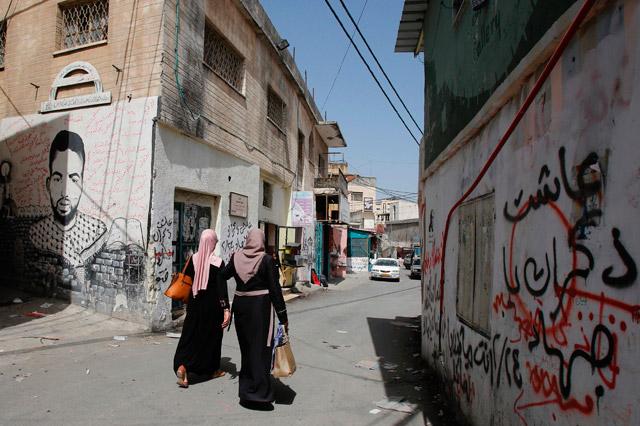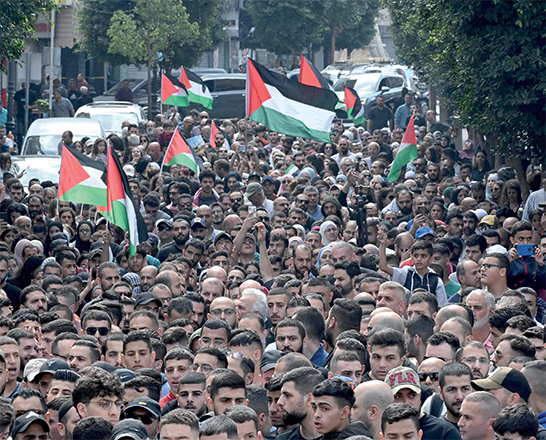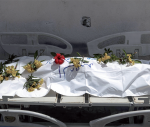You are here
Palestinian refugees’ dreams of returning home fade
By AFP - Jun 02,2017 - Last updated at Jun 02,2017

Palestinians walk past graffiti in Dheisheh Refugee Camp near the West Bank town of Bethlehem on May 14 (AFP photo)
AL WIHDAT REFUGEE CAMP — Fifty years ago, Sobhi Awwad left the ancient West Bank city of Jericho with his parents, running to dodge the crossfire from battling Jordanian and Israeli soldiers.
Today, living in a refugee camp in Amman, his seven children and 15 grandchildren know his Palestinian homeland only through his stories and those of others who fled.
"The past will never come back. I wish I had died in Jericho and not come here so I wouldn't have to carry what I carry in my memory today," he said. "Our life was simple, but very happy. There were good things in Jericho."
Awwad is among the some 300,000 displaced Palestinians from the 1967 war and its immediate aftermath.
Over the past five decades, the tent that the family pitched about 40km from Jericho has been replaced by a house, and Al Wihdat camp in which it stands looks much like any other neighbourhood in the capital.
One difference is the graffiti proclaiming that the refugee camps are just a way station, a "waiting room before the return" — a message seen on posters throughout the camps of Jordan, Lebanon, Syria and the occupied Palestinian territories.
The Palestinians claim a "right of return" to homes their families fled or were driven from both in the 1948 war surrounding the creation of Israel and again in 1967.
It is one of the most contentious issues in the Israeli-Palestinian conflict.
For the Palestinian leadership, it is a right that must be negotiated painstakingly if stalled peace negotiations ever resume.
Israel says that in the same way that it took in Jews fleeing postwar Europe and Arab countries, the proper place to settle Palestinian refugees is in a future Palestinian state.
'We never forget'
Graffiti reading "we never forget" adorns the walls of homes in the Dheisheh refugee camp, in the West Bank city of Bethlehem.
The camps can be grey zones where neither the Palestinian Authority nor the Israeli army exerts much influence.
A small, parallel world is evolving where political consciousness is sharper and despair greater than in the towns and cities.
Politics are conducted differently than elsewhere in the occupied territories, where internal rivalries are fierce.
"In the camps, solidarity among people is stronger. Even political parties take unified decisions," says Louai Al Haj, a local activist.
Palestinian security forces do not often venture in, he says, making the camps towns within towns, hidden from the eyes of the authorities.
Deep distrust prevails between the Palestinian Authority (PA) and the youngsters in the camps who appear in its alleys only after dark or their faces masked, at the funerals of “martyrs” killed in clashes with Israeli forces.
For them, the PA is a body that negotiates with the occupier and which could one day, with the stroke of a pen, sign the death warrant of the right of return.
Unrest has also broken out. At the Balata camp in Nablus, there was an uptick of violence last year when Palestinian security forces launched raids to seize illegal weapons.
‘Waiting to get back on the road’
Still waiting in the Dheisheh camp to go back, Abdel Qader Al Lahham, 96, laments what has occurred over the past half-century.
Recently, one of his grandchildren obtained an Israeli permit to visit ancestral land.
“I described to him the house and even the fig tree which I had planted,” he told AFP.
But he says that love of working on the land has been lost and with it the desire to return to the villages.
The Israelis who now occupy the territory “employ the young people and sometimes pay them as much as 200 or 300 shekels ($56-$84) a day”.
With such temptations, he says: “Who is going to wear themselves out growing vegetables?”
After reflecting on the past, he points out his house in Dheisheh.
“It doesn’t even belong to me,” he sighs.
“All this is the agency’s,” he adds, referring to the United Nations agency for Palestinian refugees, UNRWA, which also provides schools and hospitals.
Mohammed Nassar and other youngsters are trying to preserve the memory of the exodus — and life before it — by restoring a pre-1948 bus.
Parked at the side of the road in Ramallah, the beige bus has been lovingly refurbished, with varnished wooden slats running along its windows and wooden panelling inside. The names of the cities it once visited run in Arabic script along its side.
In their day, Nassar said, such vehicles took travellers from Haifa to Beirut and from Jerusalem to distant Sanaa in Yemen.
After the glory days when they ferried Palestinians to the cinema in Amman or took Christian pilgrims from Damascus to Jerusalem, the last international journey of Palestinian buses was in 1967.
Then, passengers “with their suitcases left their country for another”, Nassar said. “The Palestinians are waiting to get back on the road in the opposite direction.”
Related Articles
DHEISHEH, Palestinian Territories — Israeli forces killed a Palestinian boy on Monday near Bethlehem in the occupied West Bank, the Palestin
WASHINGTON — US Ambassador to the United Nations Nikki Haley on Tuesday appeared to question the world body's count of Palestinian refugees,
RAMALLAH, occupied Palestine — Israeli troops killed nine Palestinians in multiple clashes across the occupied West Bank on Thursday, the Pa



















